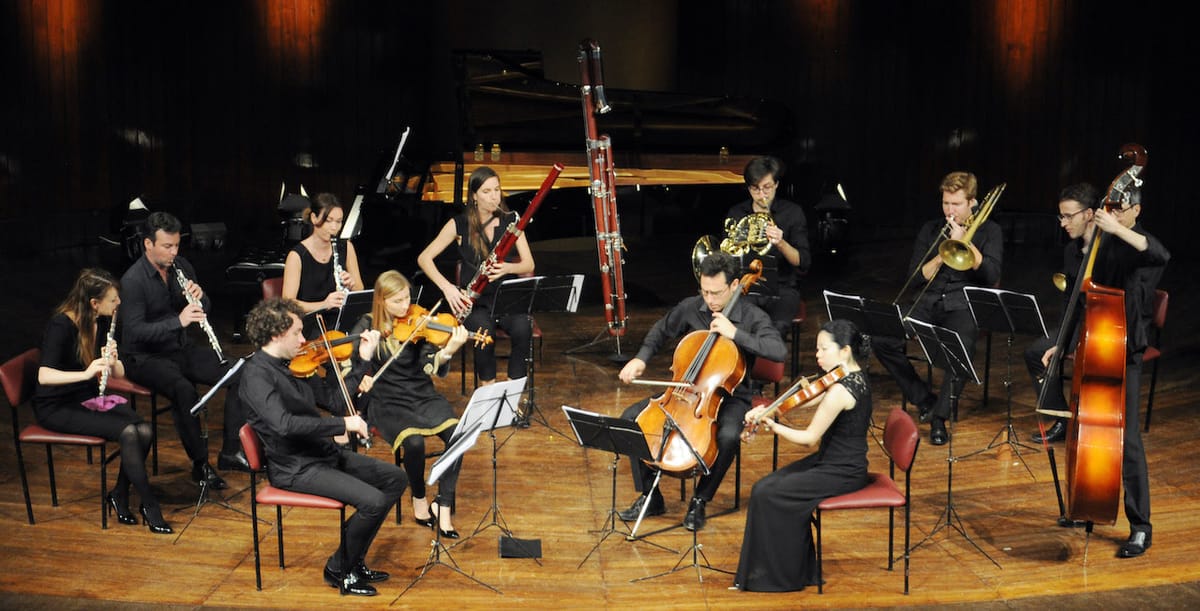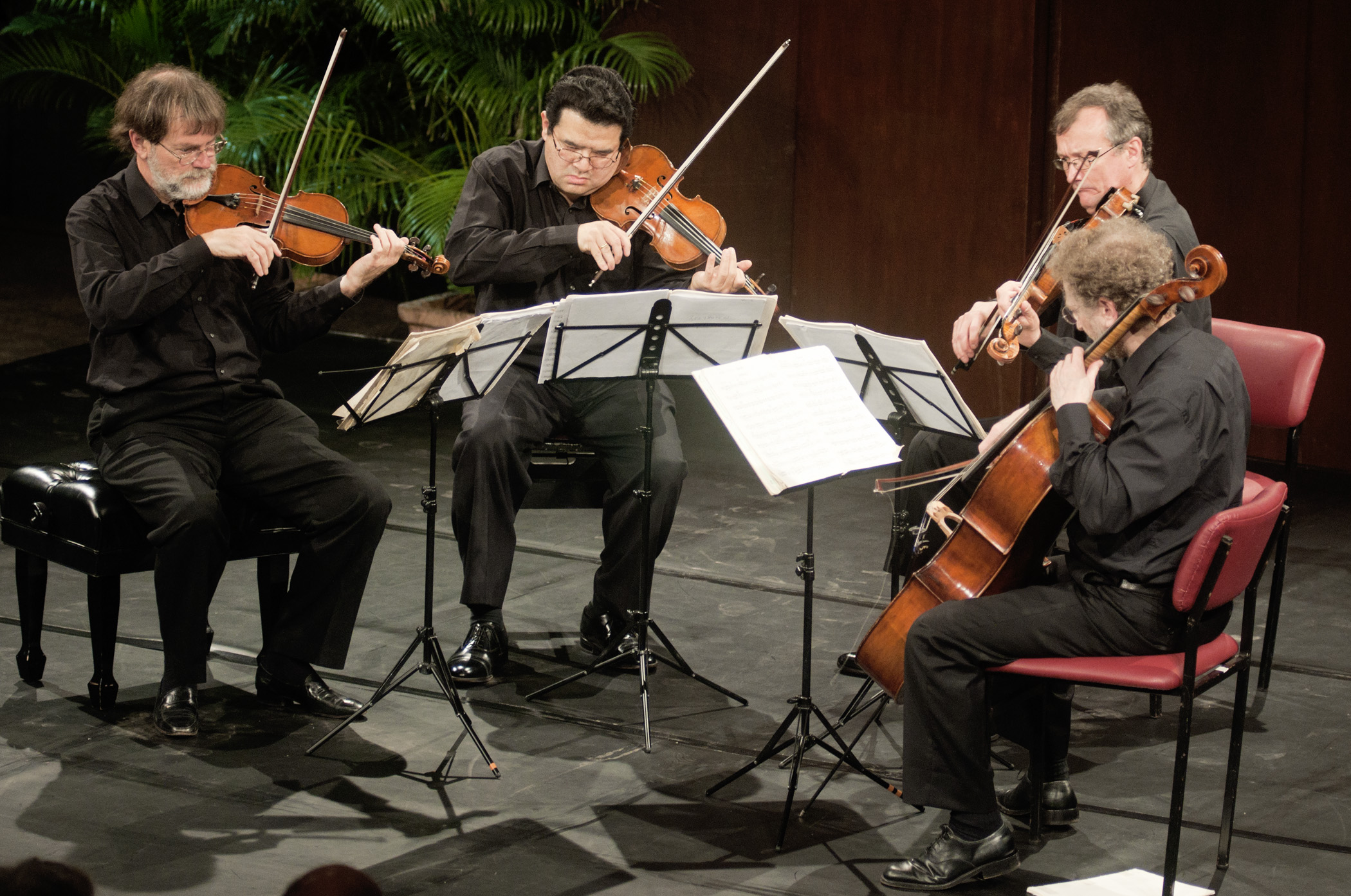Intimate Conversations

What makes chamber music special? We delve into its history and modern repertoire, and speak to violinist Ralph de Souza ahead of his chamber music performances with the Symphony Orchestra of India this month.
It was the string quartet—the most prestigious of chamber music genres—that the great German poet Johann Wolfgang von Goethe had in mind when he likened it to the conversation of intelligent individuals, but his observation holds true for much of the repertoire of chamber music. What is chamber music? Why is it regarded as a vital component of Western “art” music? What are some of the highlights of the genre? And why do musicians need to undergo training in chamber music performance?
According to Mark A. Radice, one of the earliest recorded uses of the term chamber music can be traced back to the Italian composer and music theorist Marco Scacchi, who made a tripartite division of music into musica ecclesiastica (church music), musica theatralis (theatre music) and musica cubicularis (chamber music). As per Scacchi’s classification, any instrumental music that could be played in a private residence, including orchestral works from the Baroque period such as J.S. Bach’s Brandenburg concertos, was chamber music. However, such works are nowadays classified as orchestral music. In fact, the term chamber music is generally used in modern contexts as per the following criteria.
Firstly, the number of musicians ranges from a minimum of two to a maximum of around ten players or so—i.e., duo, trio, quartet, quintet, sextet, septet, octet, nonet, and the extremely rare dectet (or decet). Secondly, unlike in orchestral music, where all string players belonging to one group, say, the first violins, play the same part, in chamber music, each player, irrespective of whatever instrument s/he plays, has an individual part. Thirdly, chamber music does not make use of a conductor. As we shall see, the last two criteria play a vital role in shaping the pedagogy of chamber music.
In terms of chamber music repertoire, it is often stated that the majority of the great chamber works involve either strings alone, or a combination of piano and strings. These include the duo sonata (often simply known as sonata) for piano and violin (or cello), trios, quartets and quintets, all for piano and strings, and the string quartet and the string quintet, the latter two genres involving string instruments alone. A reason for the high prestige enjoyed by these subgenres of chamber music is that, between the mid-18th and early-19th centuries, Haydn, Mozart, Beethoven and Schubert wrote some of their greatest works for these combinations, and later masters such as Mendelssohn, Schumann, Brahms, Borodin, Tchaikovsky, Schoenberg, Bartók and Shostakovich wrote in the wake of their achievement. That said, there is also chamber music involving winds and other unusual combinations, of which the chamber works for clarinet by Mozart, Weber and Brahms are among the most frequently performed. As this list of composers indicates, with the exception of the Russians, almost all of them are either from the German-speaking lands or belong, in terms of their training and aesthetic orientation, to the central European tradition; and the chamber music they produced was by and large for piano and strings, or for strings alone. If one considers composers either from or trained in France, for example, one finds, in addition to works for the abovementioned combinations by Fauré, Franck, Saint-Saëns, Debussy and Ravel, lesser-known examples of chamber music featuring wind instruments, such as the Trio for flute, viola and harp by Debussy, and wind sonatas and works for wind or mixed ensembles by Saint-Saëns, Gounod, Ravel, d’Indy, Enescu and others. Nor, for that matter, should we overlook the several chamber works for winds and mixed ensembles by Mozart, Schubert, Spohr and Rheinberger, some of which are among the best examples of their kind.

In the early years of the 20th century, composers all over Europe began to take a serious interest in exploring novel sonorities, and started writing for mixed chamber ensembles once again, including the human voice. Schoenberg started the trend with his Second String Quartet, which included a soprano, while his more influential Pierrot lunaire inspired several brilliant pieces by Ravel, Stravinsky, Poulenc and others. Some of them have Indian connections: Delage’s Quatre poèmes hindous for voice and ten instruments still remains one of the finest examples of a Western composer adapting Indian ragas, while Casella, Ippolitov-Ivanov, Shepherd, Sohal and others set the poetry of Rabindranath Tagore for such mixed ensembles. Here, too, an early 19th-century parallel can be found in the songs for voice, piano and one obbligato instrument (usually clarinet or violin), by Schubert, Spohr and Conradin Kreutzer. Moreover, as World War I loomed large on the horizon, Schoenberg and others started arranging orchestral works for chamber ensembles, thereby initiating a trend for avant-garde experimental works for small ensembles. Moreover, as funding for orchestras tended to become more and more challenging and the repertoire programmed by orchestras more conservative, modern composers increasingly used chamber ensembles in genres such as song cycles and operas, in which the use of piano and orchestra respectively was the norm in earlier centuries.
Chamber music thus caters to various tastes, abilities and interests. The range of repertoire from Hausmusik—music meant primarily for amateur performers—through sonatas and virtuoso concertante works for professionals enables instrumentalists to demonstrate various dimensions of their musicianship. Some works of chamber music, such as multi-movement lightweight serenades are meant for easy listening, while Beethoven’s late string quartets provide no mean interpretive challenges to both performers and listeners. Arrangements and original works for new, non-standard combinations enable musicians to explore genres that were not previously associated with chamber music. Indeed, in modern times, some chamber music groups have become well known for specialising in certain repertoires: the Arditti Quartet and the Ensemble intercontemporain, for instance, specialise in music by living 20th-century European composers, while the Kronos Quartet specialises in modern cross-over repertoires.
Chamber music is, therefore, richly rewarding to both the professional instrumentalist and the interested listener. Many orchestras have formed chamber music ensembles from among its members, and in April this year, the distinguished chamber musician and pedagogue, Ralph de Souza, will be visiting Mumbai for chamber music performances at the NCPA with members of the SOI. Mumbai-born de Souza initially studied the violin with his father, a doctor, before going on to study at the Yehudi Menuhin School at the age of 10. He subsequently went to the Curtis Institute and the International Musicians Seminar in Prussia Cove, studying with Ivan Galamian, Jaime Laredo and Sándor Végh. Appearing as a soloist with Yehudi Menuhin, de Souza subsequently joined the Endellion String Quartet, one of the leading string quartets in the U.K., in 1986, and remained with them till 2019. He also taught for several years at the Menuhin School. Here are excerpts from an interview with de Souza.

Suddhaseel Sen: We look forward to your arrival in Mumbai. Could you please tell us what you plan to do once you are here?
Ralph de Souza: Some things are at the planning stage at the moment, but I will be giving some concerts with members of the SOI in April. I will also give some classes in chamber music performance to the members.
SS: You are scheduled to perform string quartets by Beethoven and Dvorˇák, and Schubert’s “Trout” Quintet. Could you tell us a little about why these pieces were chosen?
R de S: Mr. Khushroo Suntook, Chairman of the NCPA, and Marat Bisengaliev, Music Director of the SOI, chose the pieces, which are among the cornerstones of the chamber music repertoire. Playing them will be a learning experience for the members of the SOI, while audiences will also have the pleasure of hearing the pieces live. Listening to recordings is not quite the same thing, and it will be great to have, over time, a dedicated audience for chamber music. And finally, the presence of pianist Fali Pavri for the concerts also played a decisive role in the choice of the “Trout”.
SS: Musicians stress the need for performers to undergo training in chamber music. Could you tell us what musicians can learn from chamber music?
R de S: In one word—everything! In chamber music, each instrumentalist plays his or her own part. The chamber musician must, therefore, come to the fore as an individual, which is what is also required of a soloist. But since there is no conductor, no one tells the musician what to do: he or she has to think through things. And that requires a chamber music player to be a really good listener. At the same time, a chamber musician also needs to be part of a group and arrive at artistic decisions at an individual as well as a group level. Isn’t life like that in some ways? So yes, all of these things make the art of chamber music playing an essential component of the learning and professionalising experience.
SS: Other than giving concerts, do you have any other activities in mind when you are here in Mumbai?
R de S: Oh yes—I am very much interested in coaching performers in the key works of the repertoire. Many students nowadays look out for the most recherché repertoire to perform, but I think that musicians must have a strong grounding in the foundations, which comes only from knowing those classics that shaped the repertoire and set standards for everything that came later. Also, what is most crucial for me is the process of learning—how you learn a piece and apply its lessons to other repertoire is more important than just learning a particular piece. That’s where chamber music performance becomes particularly interesting—you are using your training to make decisions yourself, instead of being told what to do by a conductor.
SS: The pieces you are going to perform all feature strings, or strings and piano. Are you open to the idea of coaching wind players?
R de S: Oh yes, absolutely! I’d be happy to coach not just string players, but players of other instruments too. Unfortunately, the chamber music repertoire for wind instruments is smaller than that for strings, or piano and strings. But there’s no reason why we should not play that repertoire.
SS: Some chamber music groups create profiles of their own, either in terms of the composition of the instrumentalists, or in terms of repertoire. Do you think that creating any such profile in the context of the SOI is feasible?
R de S: One of the problems of forming mixed chamber music ensembles is a logistical one: while the instruments required for piano trios, quartets and quintets, or string quartets and quintets are quite standard, those for mixed chamber ensembles vary quite a bit from piece to piece. So the question that one has to deal with is: how many musicians do we hire for a concert? As for specialisation in repertoire, I think that we have a more immediate task at hand, namely, that of coaching orchestral musicians in the core repertoire of chamber music, and that of creating an audience base for chamber music.
SS: Thank you for taking the time to speak with me. We look forward to hearing you perform and train the members of SOI in chamber music performance.
R de S: My pleasure.
Ralph de Souza will perform with Marat Bisengaliev, Fali Pavri and the SOI on 21st and 24th April at the Tata Theatre.
By Suddhaseel Sen. Suddhaseel Sen is a literary scholar, musicologist and Associate Professor in the Department of Humanities and Social Sciences, IIT Bombay.
This piece was originally published by the National Centre for the Performing Arts, Mumbai, in the April 2022 issue of ON Stage – their monthly arts magazine.





